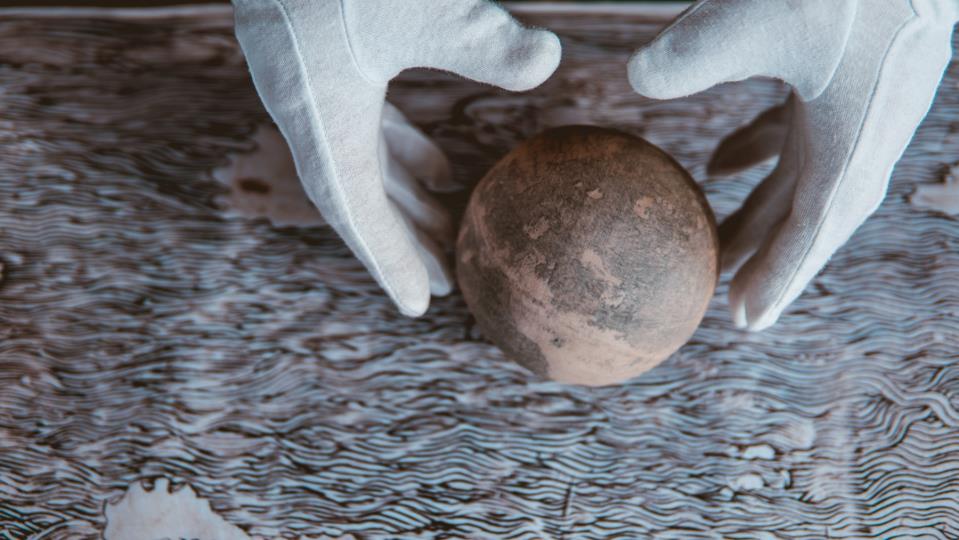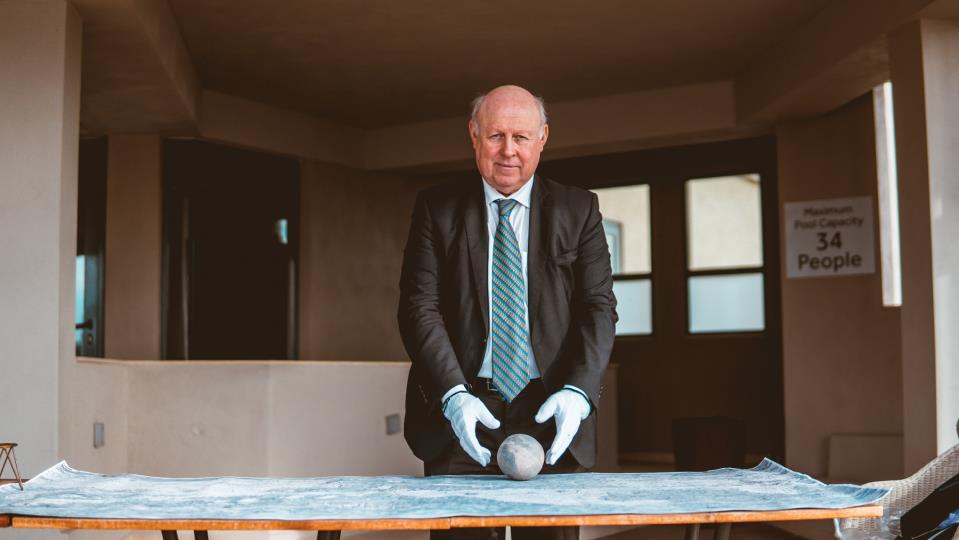A replica of the Ostrich Egg Globe (photo above), better known as the ‘da Vinci Globe’, was in Malta this week, along with the discoverer who purchased the original and wrote a book about it, Professor Stefaan Missinne (below).
Missinne, who is from Belgium but lives in Austria, is a Fellow of the Royal Geographical Society. He says that the evidence points to the globe’s creator being Italian genius Leonardo da Vinci. He came across the globe by pure chance back in 2012, while attending a map and globe fair at the venue of the Society in London.
“Rather by coincidence, I was offered this globe which had erroneously been identified as a scrimshaw from the 19th century. I was fortunate to find the item and from then on, I contacted many researchers and academics, around 80 experts, and conducted my research.” In 2018, Cambridge Scholars Publishing released a book titled ‘The Da Vinci Globe’, containing the information about the six years of research he conducted.
“The egg is the first in history to show the New World combined with the old world on a terrestrial globe. It is also the prototype of the handheld globe which is now in many children's rooms as a didactical instrument,” he said.

He adds that the Renaissance artefact is made of the lower halves of two ostrich eggs, depicting the world as it was believed to be back in 1504.
“The material used to create this artefact originates from ostriches kept in captivity in the Struzzeria of the Viscount castle of Pavia. Iconographically, the egg means new life.”
He said that the engraved globe was used as a prototype to make a copper cast known as the Lenox Globe, a treasure which sits in the New York Public Library.
The globe itself has significant differences from the world map as we know it today.
“It is incomplete. Undiscovered territories and oceans at the time are, of course, missing, such as North and Central America - Canada, USA, Mexico, Guatemala, Honduras, Nicaragua, Costa Rica, Panama, Belize are all missing. The West Coast of Latin America is missing, and is represented by a line. Australia is missing. The Pacific is missing as is the Antarctic. There are no names for oceans, seas, Meridians and Parallels. Asia is far too long and is based on Ptolemy. Africa's longitudinal width is much too small, congruent with his preparatory drawing at the British library that was erroneously believed to be the moon. The spelling is in Latin based on the BEMBO spelling that was first used in 1488. The map shows puns, for example a marine monster where the tail becomes a volcano.”

On the da Vinci globe, the Latin phrase HC SVNT DRACONES, which means ‘here are the dragons’, is seen, Missinne said, adding that Leonardo loved dragons and that cartographers did not write sentences about dragons on maps. In his book, Missinne writes “no other map or globe other than the Ostich Egg globe and the Lenox Globe contain the sentence ‘Here are the dragons’.”
A drowning sailor with a hairstyle typical for Florence between 1498 and 1505 is also depicted, and only one city is engraved - not Rome, not Jerusalem, but Calicut, in India, a spice port, he said. “This is because of the importance of spices at the time.”
The map also depicts a large island in the southern Indian Ocean which, in reality, does not exist. Missinne writes in his book: “One possible explanation for the depiction of this large anonymous island may be that, for a long period of time, the Indian Ocean was thought to be an enclosed Ocean.” Recent research showed that Roger Bacon misquoted Pliny regarding the location of the so-called Region of Patala, placing it South of the Capricorn, he said. “On the Jagiellonian globe in Cracow dating from c. 1509, based on the Lenox Globe, this island contains the text AMERICA NOVITER REPERTA, which means newly discovered America. It is the oldest naming of America on a globe.”
So how conclusive is the evidence that da Vinci created this globe?

According to Missinne, “the evidence is unambiguous.”
Prof. Missinne gave some examples of the evidence pointing to Leonardo da Vinci being the globe’s creator.
“The mathematical evidence is there. Only Leonardo wrote 7,000 miles as being the diameter of the world, and he wrote it twice. That 7,000 miles is what he had in his mind when he made that globe. We are not talking about English miles, but Italian nautical miles. Leonardo also draws the world with a counterweight. The globe does not have a stand, but it has a weight inside. The North is always on top.”
“Nobody else wrote a recipe to add arsenic to copper in order to prevent corrosion, except Leonardo. In other words, if you look at the Lenox Globe, it does not have corrosion. All copper always has corrosion, but that globe does not.”

On the surface of the da Vinci Globe (the Ostrich egg globe), a small red droplet of copper is found and it was tested and it contained traces of arsenic, he said. “So this globe has been in a casting environment. Leonardo also invented the reverse perspective, which is when he sees something far away he draws it larger. The ship depicted out at sea is huge when compared to the one depicted in the Mediterranean.”
He said that Leonardo da Vinci's preparatory drawing at the British library, erroneously believed to be the Moon, shows the same short longitudinal width of Africa.
“The globe is also incomplete, and Leonardo is known for that.”
Among other things, he said that a left-handed person created the da Vinci Globe, adding that the only left-handed person in da Vinci’s workshop was the master Leonardo himself.
“Da Vinci also wrote about his globe in 1504, using the phrase ‘Il mio mappamondo con’ Giovanni Benci.’ Which translates to ‘my globe which has Giovanni Benci’. Giovanni de’ Benci was the brother of Ginevra de' Benci whose portrait which da Vinci painted hangs in the National Gallery of Art in Washington DC."
As for Malta’s depiction on the map, Malta is hardly seen, or is at best a small dot. “You have the area of Corsica, Sardinia, Sicily, Tunisia and the Pantelleria channel, with the Atlantic Phoenician and Atlantic Ionian currents. But as Malta is not very big and the scale of the globe is 1 to 80.000.000 Malta is really only a small dot.”
Upon the invitation of the Malta Map Society, Professor Missinne was in Valletta this week to deliver a lecture on the discovery of the Leonardo da Vinci Globe dating from 1504.